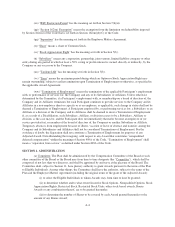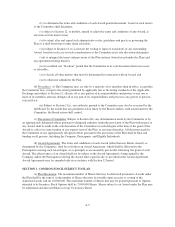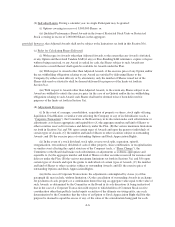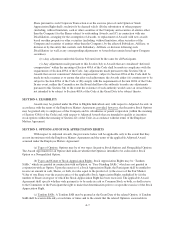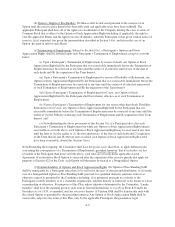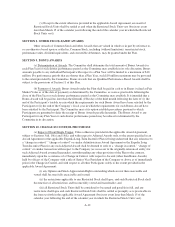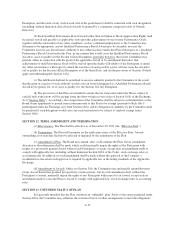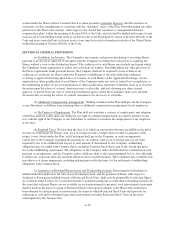TripAdvisor 2012 Annual Report Download - page 194
Download and view the complete annual report
Please find page 194 of the 2012 TripAdvisor annual report below. You can navigate through the pages in the report by either clicking on the pages listed below, or by using the keyword search tool below to find specific information within the annual report.
Termination of Employment, during the two-year period following a Change in Control, by the Company other
than for Cause or Disability or by the Participant for Good Reason (as defined below):
(i) any Options and Stock Appreciation Rights outstanding as of such Termination of Employment
which were outstanding as of the date of such Change in Control (including any Options and Stock
Appreciation Rights that became vested pursuant to Section 10(a)) shall be fully exercisable and vested
and shall remain exercisable until the later of (i) the last date on which such Option or Stock
Appreciation Right would be exercisable in the absence of this Section 10(c) and (ii) the earlier of
(A) the first anniversary of such Change in Control and (B) expiration of the Term of such Option or
Stock Appreciation Right;
(ii) all Restricted Stock outstanding as of such Termination of Employment which were
outstanding as of the date of such Change in Control shall become free of all restrictions and become
fully vested and transferable; and
(iii) all Restricted Stock Units outstanding as of such Termination of Employment which were
outstanding as of the date of such Change in Control shall be considered to be earned and payable in
full, and any restrictions shall lapse and such Restricted Stock Units shall be settled as promptly as is
practicable (but in no event later than March 15 of the calendar year following the end of the calendar
year in which the Restricted Stock Units vest).
(d) For purposes of this Section 10, “Good Reason” means (i) “Good Reason” as defined in any
Individual Agreement or Award Agreement to which the applicable Participant is a party, or (ii) if there is no
such Individual Agreement or if it does not define Good Reason, without the Participant’s prior written consent:
(A) a material reduction in the Participant’s rate of annual base salary from the rate of annual base salary in effect
for such Participant immediately prior to the Change in Control, (B) a relocation of the Participant’s principal
place of business more than 35 miles from the city in which such Participant’s principal place of business was
located immediately prior to the Change in Control or (C) a material and demonstrable adverse change in the
nature and scope of the Participant’s duties from those in effect immediately prior to the Change in Control. In
order to invoke a Termination of Employment for Good Reason, a Participant shall provide written notice to the
Company of the existence of one or more of the conditions described in clauses (A) through (C) within 90 days
following the Participant’s knowledge of the initial existence of such condition or conditions, and the Company
shall have 30 days following receipt of such written notice (the “Cure Period”) during which it may remedy the
condition. In the event that the Company fails to remedy the condition constituting Good Reason during the Cure
Period, the Participant must terminate employment, if at all, within 90 days following the Cure Period in order
for such Termination of Employment to constitute a Termination of Employment for Good Reason.
(e) Notwithstanding the foregoing, if any Award is subject to Section 409A of the Code, this Section 10
shall be applicable only to the extent specifically provided in the Award Agreement or in the Individual
Agreement.
SECTION 11. QUALIFIED PERFORMANCE-BASED AWARDS; SECTION 16(b)
(a) The provisions of this Plan are intended to ensure that all Options and Stock Appreciation Rights
granted hereunder to any Participant who is or may be a “covered employee” (within the meaning of
Section 162(m)(3) of the Code) in the tax year in which such Option or Stock Appreciation Right is expected to
be deductible to the Company qualify for the Section 162(m) Exemption, and all such Awards shall therefore be
considered Qualified Performance-Based Awards and this Plan shall be interpreted and operated consistent with
that intention (including, without limitation, to require that all such Awards be granted by a committee composed
solely of members who satisfy the requirements for being “outside directors” for purposes of the Section 162(m)
Exemption (“Outside Directors”)). When granting any Award other than an Option or Stock Appreciation Right,
the Committee may designate such Award as a Qualified Performance-Based Award, based upon a determination
that (i) the recipient is or may be a “covered employee” (within the meaning of Section 162(m)(3) of the Code)
with respect to such Award, and (ii) the Committee wishes such Award to qualify for the Section 162(m)
A-14


